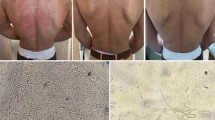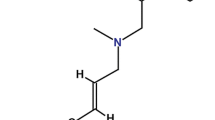Abstract
Objective
To evaluate the synergistic effects of tetrandrine (TET) on the antifungal activity of topical ketoconazole (KCZ) in the treatment of dermatophytoses.
Methods
The minimum inhibitory concentrations (MICs) for KCZ and combined KCZ and TET were compared in vitro. A randomized, double-blind trial was conducted among 97 patients with dermatophytoses who were assigned to 3 groups and received: treatment with combination of 2% KZC and 2% TET cream (KCZ + TET group), or only 2% KZC cream (KCZ group), or 2% TET cream (TET group). Patients with tinea corporis and/or tinea cruris were treated for 2 weeks, separately. The patients with tinea pedis and/or tinea manuum were treated for 4 weeks.
Results
Compared with KZC alone, combined use of KZC and TET showed lower MICs against clinical isolates of dermatophytes (P<0.05 for all). In the patients with tinea corporis and/or tinea cruris, the rates of overall cure (clinical cure plus mycologic clearance) were 81.25% vs. 33.33% for combined treatment and KZC monotherapy, respectively, after 4 weeks. All clinical indices were significantly different between the combination therapy and only KCZ therapy groups (P<0.05). Among the patients with tinea pedis and/or tinea manuum after 4 weeks treatment, the overall cure rates in the KCZ + TET group and KCZ group were 75.00% vs. 40.00%, respectively. In the KCZ + TET group, all the clinical indices were significantly better than those in the KCZ group and TET group (P<0.05). The rates of overall efficacy in the TET group were all zero. No local skin redness or itching was observed during TET treatment. No clinically significant changes were found in post-treatment routine blood, urine, or stool tests, ECG, or tests for liver and kidney function; no serious adverse events occurred.
Conclusion
TET synergistically enhanced the clinical efficacy of topical KZC cream in the treatment of dermatophytoses.
Similar content being viewed by others
References
Havlickova B, Czaika VA, Friedrich M. Epidemiological trends in skin mycoses worldwide. Mycoses 2008;51(4):2–15.
Ghannoum MA, Elewski B. Successful treatment of fluconazole-resistant oropharyngeal candidiasis by a combination of fluconazole and terbinafine. Clin Diag Lab Immunol 1999;6:921–923.
Fohrer C, Fornecker L, Nivoix Y, Cornila C, Marinescu C, Herbrecht R. Antifungal combination treatment: a future perspective. Int J Antimicrob Agents 2006;27(Suppl 1): 25–30.
Havlickova B, Friedrich M. The advantages of topical combination therapy in the treatment of inflammatory dermatomycoses. Mycoses 2008;51(14):16–26.
Li F, Zhang H. In vitro study of the synergistic effect of tetrandrine and fluconazole against Candida albicans. Chin J Dermatol (Chin) 2006;39:454–456.
Wang K, Zhang H, Jiang H, Shi J, GAO A, He H, et, al. In vivo study on tetrandrine as a synergist to fluconazole in murine model of vaginal candidiasis. Chin J Zoonoses (Chin) 2007;23:474–478.
Gao A, Zhang H, Mo H, Jiang H, Wang K, Chao H. Molecular mechanism of the synergy between tetrandrine and fluconazole against Candida albicans. Chin J Dermatol (Chin) 2008;41:97–100.
Li F, Zhang H, Shan K. In vitro study on the synergistic effect and mechanism of tetrandrine to fluconazole against hyphal form of Candida albicans. Chin J Zoonoses (Chin) 2009;25:13–16.
Zhang H, Gao A, Li F, Zhang G, Ho HI, Liao W. Mechanism of action of tetrandrine, a natural inhibitor of Candida albicans drug efflux pumps. Yakugaku Zasshi 2009;129:623–630.
Shi J, Zhang H, Zhang Z, Gao A, Wang K. Clinical investigation on the synergistic effect of tetrandrine on the antifungal activity of fluconazole for vulvovaginal candidiasis. Chin J Zoonoses (Chin) 2009;25:1121–1123.
Zhang H, Wang K, Zhang G, Ho HI, Gao A. Synergistic anti-candidal activity of tetrandrine on ketoconazole: an experimental study. Planta Med 2010;76:53–61.
Zhang D, Zhang H, Li H, Li S, Shi J. In vivo study on tetrandrine as a synergist to econazole against Trichophyton mentagrophytes. Chin J Zoonoses (Chin) 2010;26:222–225.
Liu C, Zhang H, Xiang S, Zhang D, Su Y. Experiment on tetrandrine as a synergist to bifonazole against Trichophyton mentagrophytes in vivo. Chin J Dermatovenereol (Chin) 2010;24:207–210.
Ogawa Y, Hiruma M. Dermatophytosis: a summary of dermatomycosis as a proposal for future revision of the guidelines. Nippon Ishinkin Gakkai Zasshi 2009;50:199–205.
Mochizuki T. Diagnosis of cutaneous fungal infection. Jpn J Med Mycol 2009;50:195–198.
Kane J, Summerbell R, Sigler L, Krajden S, Land G. Laboratory handbook of dermatophytes: a clinical guide and laboratory manual of dermatophytes and other filamentous fungi from skin, hair, and nails. Mycopathologia 1999;147:113–114.
CLSI/Clinical and Laboratory Standards Institute — Reference method for broth dilution antifungal susceptibility testing of conidium-forming filamentous fungi. Wayne 2002 (Approved Standard M38-A).
Borelli C, Klövekorn G, Ernst TM, Bödeker RH, Korting HC, Neumeister C. Comparative study of 2% sertaconazole solution and cream formulations in patients with tinea corporis, tinea pedis interdigitalis, or a corresponding candidosis. Am J Clin Dermatol 2007;8:371–378.
Ramam M, Prasad HR, Manchanda Y, Khaitan BK, Banerjee U, Mukhopadhyaya A, et al. Randomised controlled trial of topical butenafine in tinea cruris and tinea corporis. Indian J Dermatol Venereol Leprol 2003;69:154–158.
Singal A, Pandhi D, Agrawal S, Das S. Comparative efficacy of topical 1% butenafine and 1% clotrimazole in tinea cruris and tinea corporis: a randomized, double-blind trial. J Dermatol Treat 2005;16:331–335.
Snelders E, van der Lee HA, Kuijpers J, Rijs AJ, Varga J, Samson RA, et al. Emergence of azole resistance in Aspergillus fumigatus and spread of a single resistance mechanism. Plos Med 2008;5:219.
Wroblewska MM, Swoboda-Kopec E, Rokosz A, Krawczyk E, Marchel H, Luczak M. Epidermiology of clinical isolates of Candida albicans and their susceptibility to triazoles. Int J Antimicrob Agents 2002;20:472–475.
da Matta DA, de Almeida LP, Machado AM, Azevedo AC, Kusano EJ, Travassos NF, et al. Antifungal susceptibility of 1 000 Candida bloodstream isolates to 5 antifungal drugs: results of a multicenter study conducted in São Paulo, Brazil, 1995–2003. Diagn Microbiol Infect Dis 2007;57:399–404.
Xu C, Liu W, Chen Z, Wang Y, Xiong Z, Ji Y. Effect of prenatal tetrandrine administration on transforming growth factor-beta1 level in the lung of nitrofen-induced congenital diaphragmatic hernia rat model. J Pediatr Surg 2009;44:1611–1620.
Chen B, Sun Q, Wang X, Gao F, Dai Y, Yin Y, et al. Reversal in multidrug resistance by magnetic nanoparticle of Fe3O4 loaded with adriamycin and tetrandrine in K562/A02 leukemic cells. Int J Nanomed 2008;3:277–286.
Author information
Authors and Affiliations
Corresponding author
Additional information
Supported by the National Natural Science Foundation of China (No. 30972660), Foundation of Science and Technology Planning Project of Guangdong Province, China (No. 2009B030801015 and No. 2008B030301350)
Rights and permissions
About this article
Cite this article
Shi, Jp., Zhang, H., Zhang, Zd. et al. Synergistic effects of tetrandrine on the antifungal activity of topical ketoconazole cream in the treatment of dermatophytoses: A clinical trial. Chin. J. Integr. Med. 17, 499–504 (2011). https://doi.org/10.1007/s11655-010-0782-3
Received:
Published:
Issue Date:
DOI: https://doi.org/10.1007/s11655-010-0782-3




